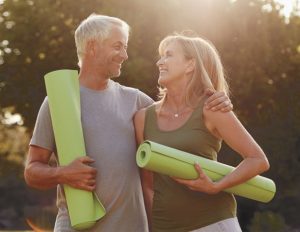By Jacob Ober, PT, DPT, ATC


The gradual loss of bone density is a natural process that occurs as we age, particularly in women after menopause due to decreased estrogen levels. Other factors contributing to bone loss include certain medications, chronic medical conditions, a sedentary lifestyle, low calcium and vitamin D intake, and genetics.
During menopause, women experience a decline in estrogen levels, which can lead to a decrease in bone density. Estrogen plays a critical role in bone health by inhibiting the activity of cells that break down bone tissue, known as osteoclasts, and stimulating the activity of cells that build new bone tissue, known as osteoblasts. As estrogen levels decline, there is a shift in the balance between bone breakdown and bone formation, resulting in a net loss of bone density over time.
Just as an increase of estrogen improved calcium absorption in adolescence, the drop in estrogen associated with menopause negatively impacts a woman’s calcium stores. As calcium stores deplete, bone mass diminishes, with the average woman losing around 10% of bone mineral density in the first five to six years of menopause.
This loss of bone density can increase the risk of fractures, particularly in the spine, hip, and wrist. In fact, postmenopausal women are at a much higher risk of developing osteoporosis than men or premenopausal women. These fractures can result in significant pain, disability, loss of independence, and increased risk of morbidity and mortality.
Though the effect is not as drastic, men are also at risk for developing osteoporosis. On average, by the age of 65–70, men are losing bone mineral density at the same rate as their female counterparts.
There are a number of factors that can increase the rate at which you lose bone density. For example, smoking, excessive alcohol consumption, a sedentary lifestyle, and a diet low in calcium and vitamin D can all contribute to bone density loss.
On the flip side, there are preventive measures that allow you to maintain bone density as you age, including regular weight-bearing exercise, a healthy diet rich in calcium and vitamin D, and avoidance of smoking and excessive alcohol consumption. In some cases, medications such as bisphosphonates or hormone replacement therapy may also be recommended to slow or reverse bone density loss.
Weight-bearing exercises are a type of physical activity that requires the body to work against gravity, stimulating bone growth and helping to counteract the loss of bone density that can occur with aging, menopause, or other factors. Here are some examples of weight-bearing exercises that can help to maintain or improve bone density:
1. Walking: Walking is a simple and accessible weight-bearing exercise that can be done almost anywhere. It is low-impact and gentle on the joints, making it a great option for beginners or those with mobility issues.
2. Jogging or running: More high-impact than walking, jogging or running can provide a greater stimulus to bone growth. However, it may not be suitable for everyone, particularly those with joint pain or other health concerns.
3. Playing a sport: Participating in racquet sports combines benefits of weight-bearing aerobic activity with cardiovascular fitness. Alternatively, benefits of playing golf involve walking on inclines as well as placing appropriate stress on the muscles and bones.
4. Weightlifting: Resistance training with weights or resistance bands can help to build muscle mass and stimulate bone growth. It is important to work with a qualified trainer to ensure proper technique and safety.
5. Yoga or Pilates: These forms of exercise focus on improving strength, flexibility, and balance, and can also provide a weight-bearing stimulus to bones.
6. Hiking or stair climbing: Activities that involve climbing up and down stairs or hiking up hills can be an effective weight-bearing exercise that also provides cardiovascular benefits.
It is important to engage in weight-bearing exercises on a regular basis, ideally at least 30 minutes per day, to help maintain or improve bone density. However, it is also important to work with a healthcare provider or qualified exercise professional to develop a safe and appropriate exercise program for your individual needs and fitness level.
Early detection of bone density loss is important to implement preventive measures and slow disease progression. Screening for osteoporosis is recommended for women over 65 and men over 70 and individuals with risk factors such as a family history of osteoporosis or previous fractures.
At Performance Optimal Health, we use comprehensive research and the latest technology to incorporate the four pillars of optimal health (exercise, recovery, nutrition, stress management) into your care. Each pillar plays a significant role in your optimal health journey, and using tools and services from each of the pillars can greatly enhance and expedite your path to success.
Jacob Ober, PT, DPT, ATC, is a physical therapist, certified athletic trainer and TPI Certified Golf Professional based in Naples who subspecializes in adult and athlete development.
Performance Optimal Health
2260 Logan Blvd., N, Suite 302, Naples, FL 34119
6425 Naples Blvd., Naples, FL 34109
239.342.1422
PerformanceOptimalHealth.com
 Southwest Florida's Health and Wellness Magazine Health and Wellness Articles
Southwest Florida's Health and Wellness Magazine Health and Wellness Articles
